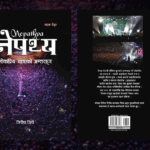The Newari community of Pharping located in Dakshinkali Municipality celebrated the centuries old Hari Shankar Jatra in the first week of September. The Jatra is observed by carrying seven idols of gods in a chariot throughout the Pharping area. The festival is believed to bring the wrath of deities upon the country if it is ever discontinued. As four of the seven idols were stolen on June 16, 1999; to ensure the continuation of the Jatra, the Guthi Sansthan has provided the community with the replicas of the four stolen Gods.
One of these stolen idols, a carved icon from Nepal Samvat 756, was located at Asian Civilisations Museum (ACM) in Singapore after being stolen for 23 years (June 16, 1999-August 2022) as shared by Lost Arts of Nepal. ACM claimed that the sculpture was acquired and displayed in the museum following appropriate procedures. However, the community has expressed their anguish and the deep cultural significance of the artifact, as recounted by Ward Chairman Sailesh Man Manandhar, “felt as if we lost our history, we lost everything”.
This case is one among thousands of stolen Nepali sculptures fueling the USD 8 billion a year illegal black market since the 1980s. While the global art market views these as merely a piece of art sold in millions, but to the Nepali community these are living deities and God that protect the community whom they worship.
The Situation: Examining the History and Scale of the Crisis
The theft of Nepal’s religious and historical objects began as early as 1765, when the statue of Narayan vanished from the Bhagwati Temple in Hanuman Dhoka. The theft of stolen historical and religious objects from Nepal saw its peak in the 1960s when the country’s border was opened to other nations with little to no security of idols, creating an opportunity for exploitation of the country’s centuries long rich cultural heritage by smugglers. During the period between 1965-1978 AD, also known as the ‘hippie’ movement, is when the problem significantly escalated, due to people relying on stealing religious sculptures to support themselves, 80% of which are now in the foreign museums displayed as art.
The immense monetary value of the himalayan treasures on the global market has fueled the illicit trading of the statues of deities regardless of the difficult and remote terrain of Himalayan regions. These items are not only valued by smugglers, but also by museums and affluent people creating an organized art trafficking ring. For instance, the smuggling of various sacred objects from one of the oldest Buddhist monasteries in Patan, I-Baha Bahi in the 1970s, concludes it as an organized art trafficking ring with involvement of many parties given the weight and size of the sculptures. However, theft of idols has only been possible due to the lack of adequate security and guard in the temple premises itself with idols often being open to the public given that people often touch them as a part of worship. Currently, the theft has led temple statues to be protected by iron cages like at Rato Machindranath temple in Lalitpur.
While some of the stolen idols have returned home, like the 16th century Uma-Maheshwor statue stolen being returned from the Brooklyn Museum, many still have not made it back home. Some instances include the linga cover at Singapore’s Asian Civilizations Museum, Nrityadevi for sale at Bonham’s Auction in New York and the 400 year old necklace from the Taleju Bhawani goddess displayed in the Art Institute of Chicago, to name a few.
Efforts to Repatriate Stolen Gods: Progress, Collaboration and Advocacy
In Patan, the theft of five large wooden sculptures from the I-Baha Bahi monastery in 1970, has left the community feeling ‘orphaned’ as the annual Gunla festival has become a ‘forlorn affair’. The absence of the original idols has created a sense of emptiness and disruption in religious ceremonies and festivals for the community as it represents a profound loss of faith and history. As a result, many communities have started taking drastic measures to protect their “artifacts”. The temples have resorted to installation of CCTV cameras, and iron cages protecting their idols, protecting their future generations from the trauma of loss as in the case of the Laxmi-Narayan statue theft which was eventually returned back to their home.
The repatriation of the stolen idols has brought a sense of closure to the communities. However, more than the return of the stolen religious objects, it is also about the restoration of the idols back to where it was, while restoring the cultural and spiritual connection that was severed. Currently, there has been a growing movement for the protection and repatriation of Nepal’s cultural heritage due to the awareness of the theft of religious idols.
The Nepal Government is actively engaged in recovering stolen idols using diplomatic channels and legal avenues like the 1970 UNESCO Convention. Hon. Minister of Foreign Affair, Narayan Prakash Saud stated, “We have made it clear that they need to be reinstated to their original place and security ensured to keep these thousands-of-years-old artifacts safe”. The department of Archaeology has been working with foreign governments and museums like Yale University Art Gallery, and the Musée Guimet in France, the Victoria and Albert Museum in the UK to request for and repatriation of stolen idols. The National Museum in Kathmandu is a temporary custodian for repatriated objects until they are safely returned back to their communities. Jayaram Shrestha, the director of the National Museum, has established a special room to display repatriated items and make them accessible to the public for worship.
Along with these official and governmental institutions, activist groups like Lost Arts of Nepal which is an anonymously-run social media campaign tracing over 50 stolen artifacts, has been instrumental in locating and identifying stolen artifacts, raising public awareness and advocating for their repatriation. The Nepal Heritage Recovery Campaign, Lost Arts of Nepal, along with other various movements are relentlessly working on recovery and repatriation of the Gods that are kept as displays in various foreign museums through collaboration with the government, local communities, Department of Archaeology and other stakeholders to fund, organize and accompany the return of the stolen God.
Art Historians like Jürgen Schick and Lain Singh Bangdel are recognized for their work in recording information and images for over 200 missing deities in their respective books, “The Gods are Leaving the Country: Art Theft from Nepal” and “Stolen Images of Nepal.” Individual efforts from people like Architect Rabindra Puri who set up a museum in Bhaktapur called the Museum of Stolen Arts to display replicas of trafficked cultural heritage has been able to educate the public and highlighted the scale of the loss.
However, the repatriation has not been easy for Nepal. As the artifacts date back to centuries, it has been difficult to establish a clear provenance due to lack of documentation. This also means that Nepal has not been able to give concrete proof that an artifact originated from a specific location in Nepal. Through involvement of local communities who are more knowledgeable about the artifacts for the documentation and national registry of cultural artifacts, a clear provenance can be established.
A key challenge in repatriation is navigating complex legal frameworks, but developing clear guidelines and protocols could streamline the process and ensure the safe return of stolen cultural artifacts. The temples and shrines need to have strong security measures in order to prevent future thefts. The progress of repatriation has only been possible due to the continuous public awareness and collaborative effort to educate the public about the value that our cultural heritage holds.
A Call to Action for Preserving Nepal’s Cultural Legacy
A significant number of stolen idols remain unaccounted for, which has highlighted the need for continued efforts to locate and repatriate them. This has a lasting impact on communities in Nepal, extending beyond material loss, affecting their spiritual well-being and cultural identity.
The resilience and unwavering commitment of Nepali community embodies the nation’s history, identity and heritage. The repatriation of stolen idols is the reflection of it. The collaborative effort has led to many stolen religious idols and objects to be acknowledged and some returned back to where they belong, while others are in the process of repatriation. The return of idols brings a sense of hope and justice, but also underscores the urgent need for greater protection and international cooperation to preserve Nepal’s rich cultural heritage for future generations.
Annie holds a Bachelor's degree in Business Administration (Finance) from Pokhara University. She is an aspiring public policy professional, driven by social impact and sustainability working towards advancing meaningful development initiatives. She is currently a NEF intern at Nepal Economic Forum, boosting her program management and analytical skills.





